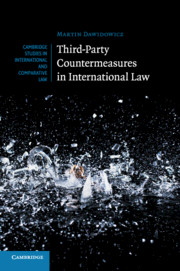Book contents
- Frontmatter
- Contents
- Foreword
- Preface
- Table of Cases
- List of Abbreviations
- 1 Introduction
- 2 Third-Party Countermeasures and the ICJ
- 3 Third-Party Countermeasures in the ILC
- 4 Third-Party Countermeasures in State Practice
- 5 Permissibility of Third-Party Countermeasures: Evaluation
- 6 Third-Party Countermeasures and Safeguards against Abuse
- Conclusion
- Bibliography
- Index
- Miscellaneous Endmatter
6 - Third-Party Countermeasures and Safeguards against Abuse
Published online by Cambridge University Press: 01 June 2017
- Frontmatter
- Contents
- Foreword
- Preface
- Table of Cases
- List of Abbreviations
- 1 Introduction
- 2 Third-Party Countermeasures and the ICJ
- 3 Third-Party Countermeasures in the ILC
- 4 Third-Party Countermeasures in State Practice
- 5 Permissibility of Third-Party Countermeasures: Evaluation
- 6 Third-Party Countermeasures and Safeguards against Abuse
- Conclusion
- Bibliography
- Index
- Miscellaneous Endmatter
Summary
It was concluded in the previous chapter that recourse to third-party countermeasures is permissible under international law; however, this is only so if they are strictly limited to the requirements of the situation. Prudence dictates that third-party countermeasures must be subject to appropriate conditions and limitations in order to minimize the risk of abuse and seek to ensure that they are ‘kept within generally acceptable bounds’. The concept of countermeasures expresses a basic tension between order and disorder in international relations. Tools of law enforcement aim to reinstate order, ruptured by illegality, but unilateral self-help measures (notably, countermeasures) entail a risk of disorder and further rupture. The ILC, largely relying on pre-existing customary international law, sought to balance these concerns by devising an operational system of safeguards for the taking of countermeasures in Articles 49–53 ARSIWA.
It may be recalled from Chapter 3 that, having provisionally adopted Draft Article 54 [2000] which recognized the entitlement to adopt third-party countermeasures, the ILC Drafting Committee in 2000 simply added in its third paragraph: ‘Where more than one State takes countermeasures, the States concerned shall cooperate in order to ensure that the conditions laid down by this Chapter [i.e. what became Articles 49–53 ARSIWA] for the taking of countermeasures are fulfilled’. The inclusion of Article 54 ARSIWA in the chapter on countermeasures makes it clear that the ILC intended only to reserve its position with respect to the permissibility of third-party countermeasures. The term ‘lawful’ in Article 54 ARSIWA refers to the requirement that any third-party countermeasure would always have to comply with Articles 49–53 ARSIWA. The 2005 IDI Krakow Resolution likewise affirms that third-party countermeasures are essentially permissible ‘under conditions analogous to those applying to a State specifically affected by the breach’. Thus the general safeguards regime for countermeasures, which applies mutatis mutandis to third-party countermeasures, is the subject of this final chapter. It will examine the object and limits of countermeasures in the intimately related Articles 49 and 53 ARSIWA (6.1); the scope of excluded countermeasures in Article 50 ARSIWA (6.2); the principle of proportionality in Article 51 ARSIWA (6.3); and the procedural conditions in Article 52 ARSIWA (6.4).
- Type
- Chapter
- Information
- Third-Party Countermeasures in International Law , pp. 285 - 382Publisher: Cambridge University PressPrint publication year: 2017
- 1
- Cited by

